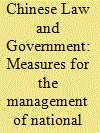| Srl | Item |
| 1 |
ID:
118867


|
|
|
| 2 |
ID:
114876


|
|
|
|
|
| Publication |
2012.
|
| Summary/Abstract |
In line with the Outline for Poverty Alleviation and Development in China's RuralAreas (2001-2010), the state has defined 529 counties (including banners, autono-mous counties, and municipal districts) in the central and western regions wherethe tasks of poverty alleviation and development are heavy and poor populationsare relatively concentrated as key counties for national poverty-alleviation anddevelopment work (hereinafter referred to as "key counties"). These Measuresare formulated to promote poverty-alleviation and development work in the keycounties, standardize management, and strengthen supervision.
|
|
|
|
|
|
|
|
|
|
|
|
|
|
|
|
| 3 |
ID:
171399


|
|
|
|
|
| Summary/Abstract |
Energy poverty has become one of the major challenges faced by the world's energy system. However, there is no consensus on the measure of energy poverty. Several approaches have been proposed, among which the energy poverty line has been defined as the minimum quantity of energy required for basic life, particularly for cooking and heating. This paper estimates the relationship between energy expenditure and household income and identifies the energy poverty line based on the threshold above which the energy share becomes insensitive to household income using household survey data from rural Qinghai, China. Considering the ongoing energy transition and the negative impacts of biomass energy consumption for the environment and health, the study sets a scenario in which all bioenergy consumption is replaced with electricity. The findings show that 57% of rural households in rural Qinghai are energy poor. The phase of energy poverty in terms of basic energy access has passed, so increasing the share of efficient modern energy in household energy consumption requires more attention. Considering the existence of a population that is not income poor but is energy poor, a conventional policy design that primarily targets income-poor households may be inappropriate in this case.
|
|
|
|
|
|
|
|
|
|
|
|
|
|
|
|